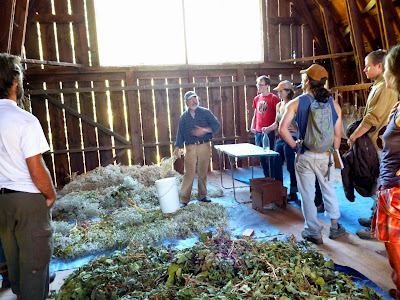Now that I’m done with my farm internship, I see myself
fitting into the food system through social justice work. Last week I was fortunate enough to attend
Multnomah County’s Food Justice Summit here in Portland. Last year, I attended the summit through
my internship with Adelante Mujeres. I
found it useful to learn about the local food and agricultural movement and
thought this year’s focus on food justice
would be especially pertinent for me.
LaDonna Redmond, a well-known food activist from Chicago,
was this year’s keynote speaker. She
talked about her entry into what is now called “food justice” when she couldn’t
find the food she needed to feed her son (who has a variety of food allergies)
in her community. That initial concern
for her son’s health led her to start urban gardens on vacant lots in Chicago,
where youth and adults could learn and work.
She now speaks around the country about her experiences to combat the
industrial food system. In her talk, she
emphasized how important it is to not just talk about food. Food justice is about introducing the lenses
of race, class, and gender and using food as a means to achieve justice. She says that we need to talk about the
histories and narratives of people of color, about Historical Trauma, and about
facilitating healing rather than just health.
This is food justice 2.0.
You can see a shorter version of the talk she gave at the
summit here (from her appearance at TedX Manhattan last year):
Here are some of the projects and organizations who
discussed their work in sessions I attended:
- The Oregon Food Bank’s Voices project is a division of OFB’s advocacy branch. Voices is all about storytelling, allowing individuals who visit food pantries and free meal sites to tell their own stories about their situations and about hunger. These stories are used to help distill myths about hunger- that people who receive emergency food boxes are lazy, make bad choices, and are taking advantage of the system. The stories collected show that food pantry recipients are generous (often going hungry in order to care for others), come from a variety of ages and backgrounds, and that getting out of poverty through personal choices is unrealistic. These individuals want the best food for their families, but what they’re making in income and receiving through SNAP is not enough.
- A few different projects are happening in Oregon’s jails and prisons to provide inmates with access to gardening. Multnomah County’s Sustainable Jails Project has a garden at their Inverness Jail (in North Portland) which grows food for the food bank. They also have a condensed (inmates at the jail typically have very short stays) version of Seed-to-Supper, a basic gardening course coordinated by Oregon Food Bank. Multnomah County also has gardening and culinary arts training programs in their juvenile system for youth on probation. These programs have an internship component where youth can learn job skills and make some money. Lastly, the Lettuce Grow Garden Foundation has helped establish gardens and provide inmate access to OSU’s Master Gardener course and the Seed-to-Supper course in all of Oregon’s state prisons.
- Partners for a Hunger Free Oregon is an advocacy and outreach organization based in Portland that works to end hunger before it begins. They helped write a statewide action plan to end hunger by increasing economic stability, cultivate a strong regional food system, and improve the food assistance safety net. They also lobby for important economic and food welfare programs.
I appreciated many speakers’ emphasis that food insecurity
was a symptom of larger societal problems.
Food justice doesn’t happen just by giving people a box of food or
starting up a grocery store in the neighborhood. Everyone needs living wages, adequate safety
nets, access to their type of food, and an outlet to facilitate healing from
past and present injustices.



















